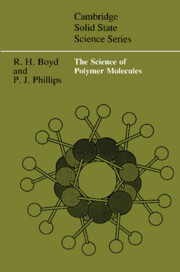Book contents
- Frontmatter
- Contents
- Preface
- 1 Polymerization: an overview
- 2 Molecular weight and molecular weight distribution
- 3 Molecular weight determination
- 4 Polymerization: kinetics and mechanism
- 5 Three dimensional architecture: conformation and stereochemical configuration
- 6 The statistical behavior of conformationally disordered chains
- 7 The interacting bond model for the average properties of coiling chains
- 8 Rubber elasticity
- 9 Solutions
- References
- Index
2 - Molecular weight and molecular weight distribution
Published online by Cambridge University Press: 29 October 2009
- Frontmatter
- Contents
- Preface
- 1 Polymerization: an overview
- 2 Molecular weight and molecular weight distribution
- 3 Molecular weight determination
- 4 Polymerization: kinetics and mechanism
- 5 Three dimensional architecture: conformation and stereochemical configuration
- 6 The statistical behavior of conformationally disordered chains
- 7 The interacting bond model for the average properties of coiling chains
- 8 Rubber elasticity
- 9 Solutions
- References
- Index
Summary
Since the achievement of the physical properties characteristic of high polymers depends critically on molecular weight, it is most important to be able to define and measure this quantity. In this chapter definitions are taken up and basic concepts illustrated, largely by the example of step polymerization. The companion conclusions with respect to chain polymerization are necessarily deferred until the treatment of polymerization kinetics is undertaken (in Chapter 4). The subject of branching and crosslinking is also introduced. In the next chapter (Chapter 3) the various methods for measuring molecular weight are considered.
Before proceeding, it is worth giving a brief overview of how certain key material properties depend on molecular weight. In doing so, no effects of molecular weight distribution are considered, only some broad generalizations that are based on average molecular weight are taken up. These properties naturally group themselves into three categories and the effect of molecular weight on each of them is different. The first category is what might be considered typical thermophysical properties such as melting point, heat capacity and, especially important, elastic properties. All of these have the characteristic that they ‘saturate’ with molecular weight. That is, they become independent of molecular weight as the latter increases. Figure 2.1 shows the melting points of alkane or paraffin crystals as chain length increases toward their high molecular weight counterpart, polyethylene.
- Type
- Chapter
- Information
- The Science of Polymer Molecules , pp. 18 - 59Publisher: Cambridge University PressPrint publication year: 1993
- 2
- Cited by



